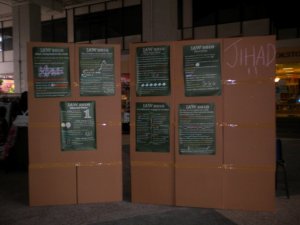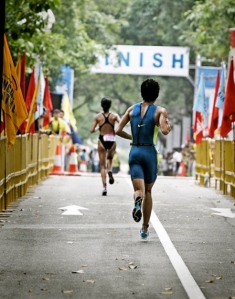Archive
Power to the People
By Nadya Huang
There is no doubt that there are many power-hungry students in the National University of Singapore. Ang Zhi Wei, a 23-year-old political science major at the university, carries his multi-plug adapter to school every day so that he can pore over his work on the laptop. Yet, he finds it difficult to even secure a seat in the library next to a power socket.
It is a common sight to see students overloading power sockets in the library with extensions and multi-plug adapters. A quick check at the university’s Central Library on a typical Wednesday afternoon will attest to that.
Although the library has over 400 power sockets available for students to use, it seems that students still find there is a shortage.
“There are really not enough power points in the Central Library,” Ang said, “You either come real early or bring a multi-plug adaptor so you can get a seat beside a power socket to do work.”
Some students also use the power sockets to charge other gadgets such as their mobile phones. These habits contribute to the Central Library’s power bill of more than $96,000 a month. The management is aware of the situation, and has taken measures to cut down power consumption in other areas to offset the high electricity bills. However, there are problems impeding these solutions.
“We try to increase the temperature of the air-conditioning in the library but certain things like books and microfilms need to be kept at a lower temperature to maintain their condition,” said Patrick Lye, principal librarian of the university’s libraries.
“We are in an old building, and the electrical infrastructure might not be able to handle it,” he said, “but we are aware of the shortages and have contacted the Office of Estate Development to find a solution.”
Students are increasingly more dependent on their mobile gadgets. They spend long hours on their laptops trying to complete their work.
While some students are less conscious about their power usage, others have been actively trying to adopt good energy habits and encouraging others to do the same.
This group of students is from NUSSU Save, a student organisation devoted to fighting climate change. In conjunction with the World Earth Hour on March 27, they organized the Earth Hour event in the university.
During the event, students folded paper lilies out of waste paper as a symbol of hope for a better tomorrow. The 2668 paper lilies collected were used to create a tree-shaped mosaic at the Sports and Recreation Centre field. The display was lighted up with light sticks as a tribute to Mother Earth. This was recorded as the largest display of paper lilies in Singapore.
At 8.30pm on the day of the event, several non-essential lights on campus were turned off. The organizers had successfully managed to convince the administration to turn off more lights this year compared to last year’s Earth Hour.
These included lights from the various faculty buildings, six halls of residences as well as facility buildings in University Hall, Yusof Ishak House and the Sports and Recreation Centre.
23-year-old Calvin Tan is the Chairperson of NUSSU Save. The second-year Life Sciences student acknowledged that Earth Hour was more of a publicity event to raise awareness.
“The event itself does not do much for the environment, but is more of a symbolic gesture directed at individuals. We did get more than 2,000 different individuals to fold paper lilies and that is 2,000 people who can help to spread the message,” said Tan.
And they are not alone in their bid to save power and cut down consumption. The university’s Office of Estate and Development and Office of Environmental Sustainability work together in several projects to reduce electrical consumption.
These projects include the replacement of conventional lamps with energy-saving lights and installation of infra-motion sensors in newly renovated toilets. The office also intends to monitor trends in excessive electrical usage on campus so that they can implement measures to prevent wastage.
With so many initiatives to cut down on energy usage, there is definitely power to the people.
NUS Students Clear Up the Struggle Within
By Nadya Huang
In an bid to correct the slant in which mainstream media has framed the concept of ‘Jihad’, the National University of Singapore’s Muslim society organised the Islamic Awareness Week 2010.
Themed “Embracing Jihad: the Struggle Within”, the event was held in the National University of Singapore on Feb. 22.
One of the organizers, Sofia Jasmani, said, “People will only remember the war and killings from the news, but Jihad simply means ‘a struggle within’. We practice it in our everyday lives like if we have difficulty in our homework or chores. That’s a struggle within too.”
The student organizers started the project to foster better public understanding of Islam. To the students, it is an important event as it is one of few that reaches out to beyond the Muslim community.
“We want to help people to differentiate the teachings of Islam and being Muslim from the picture that has been formed in the media,” said Jasmani.
Leonard Tham, a third year Economics student from the Faculty of Arts and Social Sciences, said, “I think it is important for people to understand Islam, especially with the recent burning of several churches in Malaysia.”
The week-long event had many different activities to engage the public. Jasmani said, “We wanted to choose different, more engaging programmes other than just talks to attract the audience.”
This included a debate on Monday evening about “Terrorism: Is Islam Against it?” Two students took opposing stands to debate the issue in front of an audience of 60, some of whom are from other universities such as the Nanyang Technological University and the Singapore Management University.
An interactive exhibition was held at the Central Library foyer, with posters explaining Islamic concepts such as ‘jihad’ and ‘halal’.
The response to the event has been positive, according to Jasmani.
She said, “People have been reading our posters and joining in the activities we have organized. They’re asking us questions to clarify their doubts.”
Tan Ju Ling, a fourth year student who was at the exhibit said, “I think the exhibition in the library foyer has been good – very interesting and informational.”
“The week has been a success so far in the sense we managed to reach our target audience, but we know we can only really reach people who are interested to know more,” said Jasmani.


